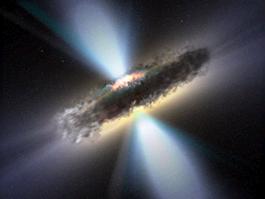An artist's depiction of the accretion of a thick ring of dust
into a supermassive black hole. The accretion produces jets of
gamma rays and X-rays. Credit: ESA / V. Beckmann (NASA-GSFC)

Physicists at Penn State have provided a mechanism by which
information can be recovered from black holes, those regions of
space where gravity is so strong that, according to Einstein's
theory of general relativity, not even light can escape. The
team's findings pave the way toward ending a decades-long debate
sparked by renowned physicist Steven Hawking. The team's work
will be published in the 20 May 2008 issue of the journal Physical
Review Letters
In the 1970s, Hawking showed that black
holes evaporate by quantum processes; however, he asserted that
information, such as the identity of matter that is gobbled up
by black holes, is permanently lost. At the time, Hawking's
assertion threatened to turn quantum mechanics--the most
successful physical theory posited by humankind--on its head,
since a fundamental tenet of the theory is that information
cannot be lost.
Hawking's idea was generally accepted by physicists until the
late 1990s, when many began to doubt the assertion. Even Hawking
himself renounced the idea in 2004. Yet no one, until now, has
been able to provide a plausible mechanism for how information
might escape from a black hole.
A team of physicists led by Abhay Ashtekar, Holder of the Eberly
Family Chair in Physics and director of the Penn State Institute
for Gravitation and the Cosmos, now has discovered such a
mechanism. Broadly, their findings expand space-time beyond its
assumed size, thus providing room for information to reappear.
To explain the issue, Ashtekar used an analogy from Alice in
Wonderland. "When the Cheshire cat disappears, his grin
remains," he said. "We used to think it was the same way with
black holes. Hawking's analysis suggested that at the end of a
black hole's life, even after it has completely evaporated away,
a singularity, or a final edge to space-time, is left behind,
and this singularity serves as a sink for unrecoverable
information."
But Ashtekar and his collaborators, Victor Taveras, a graduate
student in the Penn State Department of Physics, and Madhavan
Varadarajan, a professor at the Raman Research Institute in
India, suggest that singularities do not exist in the real
world. "Information only appears to be lost because we have been
looking at a restricted part of the true quantum-mechanical
space-time," said Ashtekar. "Once you consider quantum gravity,
then space-time becomes much larger and there is room for
information to reappear in the distant future on the other side
of what was first thought to be the end of space-time."
According to Ashtekar, space-time is not a continuum as
physicists once believed. Instead, it is made up of individual
building blocks, just as a piece of fabric, though it appears to
be continuous, is made up of individual threads. "Once we
realized that the notion of space-time as a continuum is only an
approximation of reality, it became clear to us that
singularities are merely artifacts of our insistence that
space-time should be described as a continuum."
To conduct their studies, the team used a two-dimensional model
of black holes to investigate the quantum nature of real black
holes, which exist in four dimensions. That's because
two-dimensional systems are simpler to study mathematically. But
because of the close similarities between two-dimensional black
holes and spherical four-dimensional black holes, the team
believes that this approach is a general mechanism that can be
applied in four dimensions. The group now is pursuing methods
for directly studying four-dimensional black holes.
